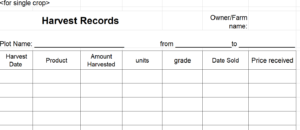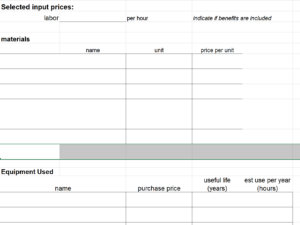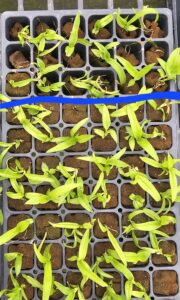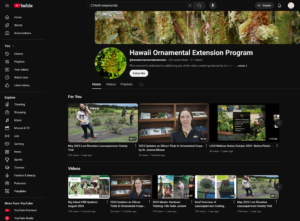Progress report for SW24-010
Project Information
PROBLEM & RESEARCH: Growers understand that the sole use of chemicals to control insect pests is not a sustainable long-term solution (Seal et al., 2013), and creates high selective pressure for pest resistance. Hawaii Floriculture and Nursery (HFN) industries’ reliance on chemical management stems from the wide range of invasive pests they encounter due to the diverse crops grown by this industry.
Silicon-medicated plant resistance to herbivorous insects has been well documented over the past two decades. This project will expand upon research by Bloese et. al. 2023 (In Review) that found significant benefits of Si to reduce various invasive invertebrates and fungal pathogens in nursery crops.
This project will conduct applied research through on-farm trials to quantify reduction in pest and disease densities, yield differentials, and changes in plant physiology among four Si augmented pesticide regimes across four species of ornamental crops. Research results will inform a resistance management strategy which will reduce growers’ reliance on chemical controls, reduce the high selective pressure for resistance, and improve overall sustainability of the industry.
SIGNIFICANCE & OUTCOMES: Hawai’i’s potted plants and cut flowers represent approximately 45% (almost $35 million) of a $77.6 million HFN industry in 2017 (HDOA Annual Summary, 2018). Additionally, HFN industries have a rich cultural and environmental significance. They produce flowers and foliage for lei and hula, as well as many native plants. Minimizing pesticide use for this industry will: (a) protect the biosecurity of native plants, (b) increase industry profitability, (c) increase the health and safety of farm systems and workers, and (d) reduce the selective pressure for resistance by invasive pests.
EDUCATION & DISSEMINATION OF RESULTS: Outreach and education objectives will incorporate research results in the development of a Si enhanced pesticide resistance management program and updated Best Management Practices (BMPs). The active participation of stakeholders in the project enhances ease of dissemination of project results through Field Days, extension publications, webinars, conferences and peer-reviewed publications. These modes of communication will ensure that the project findings reach and benefit a broad audience, including growers, researchers, industry stakeholders, and policymakers. A series of questionnaires and surveys will evaluate the long-term adoption of BMPs by growers.
Logic Model for Silicon-Enhanced Pest
Management.
|
Inputs |
Activities |
Outputs |
Outcomes |
Impact |
|
Research Expertise |
On-Farm Trials, Data collection, Analysis |
Quantified Pest Reduction |
· Reduced selective pressure |
· Improved long-term sustainable pest management practices |
|
Transdisciplinary Team (Growers, Educators, Researchers) |
On-Farm Trials, Data Collection, Analysis |
Crop Health & Yield Insights |
· Improved plant health and production; reduction of agricultural inputs |
· More resilient agriculture system to supply chain disruptions |
|
Collaboration |
Research, Analysis |
Physiological Changes |
· Improved Si application methodology for enhanced efficacy |
· Improved industry sustainability; Improved worker safety |
|
Peer to Peer Education & Outreach |
Strategy Development & Outreach |
Resistance Management Strategy |
· Reduced reliance on chemical controls and reduced pesticide usage. |
· Reduced environmental Impact; Improved profitability; and economic benefits |
This logic model illustrates the flow from resources and actions to the anticipated results and eventual broader impacts of the research and education project.
RESEARCH PLAN
Objective 1: Conduct five multi-island on-farm trials to evaluate the efficacy of four Si-augmented pesticide regimes across key ornamental crops in Hawaii. Efficacy of the four pesticide + Si-augmented treatment groups will be determined through the following sub-objectives. (Specific treatment levels are detailed in Research Plan section of the Narrative).
Subobjective 1(a): Determine yield differential and flower quality among Si treatment groups.
Subobjective 1(b): Quantify pest composition and prevalence among Si treatment groups.
Subobjective 1 (c): Quantify disease composition and prevalence among Si treatment groups.
Objective 2: Assess changes in plant physiology to better understand mechanisms of plant protection by Si to maximize resource efficiency and optimize application. This will be achieved through the following subobjectives.
Subobjective 2(a): Measure canopy size, stalk number or root mass to quantify gross plant growth across Si treatment groups.
Subobjective 2(b): Quantify Si, nutrient, and chlorophyll content in plant tissue among Si treatment groups.
Subobjective 2(c): Image leaf surfaces and tissue sections among treatments and crops to quantify stomata and trichome number and document organ size and structure, respectively, to evaluate possible morphological markers for physiological effects of Si.
Objective 3. Conduct cost-benefit analyses to assess the economic viability of using Si as an amendment in pesticide management regimes.
EDUCATION PLAN
Our Education Plan is three-fold.
Objective 1: Develop Best Management Practices (BMPs) for pesticide resistance management in nursery crops that are practical, effective, and adopted by stakeholders.
Objective 2: Promote long-term sustainability of BMP adoption through active learning and student-centered education outreach activities.
Objective 3: Reassess adoptability of BMPs by addressing concerns and misconceptions related to BMPs, providing information to mitigate perceived risks, as well as develop strategies for scaling up BMP adoption through grower-extension-researcher collaborations.
Cooperators
- - Producer
- - Producer
- - Producer
- - Producer
- - Producer
Research
This project's contract and account was not set-up until the end of Dec. 2024 and we began work early Jan 2025 until the Stop Work Order in early February.
During this time we contacted collaborator growers, began planning travel to grower farms on various islands, and began developing research protocols tailored to those individual farms. This included developing data sheets for both on-site trials and cost-benefit analysis.
Travel plans and subaward contract were put on hold following USDA ARS Travel Ban and WSARE Stop Work Order.
Project progress has been resumed and we plan to visit with collaborator growers both virtually and in-person in the coming weeks.
Below are some examples of the datasheets we created for the project.
No results at this time.
Research outcomes
The project is still in it's infancy, and we have no research results to report at this time, however, we have been scouting good candidate varieties at collaborator grower nurseries and honing experimental designs tailored to each crop, variety and cultivation system that aligns with project objectives.
One such tray of seedlings below for Burana Dendrobium orchids.
Education and Outreach
Participation summary:
Outreach objectives were planned to begin the third and fourth quarter of the second year of the project. We are still at the beginning stages of the project. To date, PI & Co-PIs have been attending Grower Association meetings, updating stakeholders on the progress of the project and receive continual feedback. We have begun planning demonstration fields with collaborator growers that will be used in future Field Day events. We have been maintaining online presence for growers so that results from this project will be included on these online platforms and continue to have a large reach. This includes the Ornamental YouTube site (see image below) and MyIPM app. We have attended professional conferences to gain insightful information to further inform this project, which include the International IPM symposium.
Outreach outcomes we are planning include:
Field-Days Occurring during the second and third year of the project (Aug 2026- Jan 2027). Farmers and researchers come together to share Best Management Practices and demonstration fields based on results of on-farm trials. Field Day events will be coordinated by entire Project Team.
Grower Workshops
Workshops hosted by CTAHR Extension Specialists & Agents throughout all three years will allow for continued state-wide coordination among the project team, growers, and stakeholders. Workshops will demonstrate application methods, rates, timing of applications and incorporation of Si
into current cultivation practices. Coordinated by Project Extension Agents and Researchers.
Research Webinar series
Research results and subsequent BMPs will be presented at the Annual HFNA Research Webinar during all three years of the project (Sept2025, & 2026). An additional five-part webinar series will be developed by Extension Agents and Specialists to target and tailor content to specific nursery groups. The series will address (1) the science behind silicon (2) the application of silicon (3) Silicon research results from the project (4) Updated BMPs
regarding pesticide resistance management program (5) Economic Analysis (Cost-Benefit Analysis results).
Grower Group/ Association Meetings
*HFNA, HENA, and OGOH are composed of hundreds of growers. This is an opportunity for growers to share and collaborate as well as specify
specific goals, issues and questions that need to be addressed through research and extension.
Demonstration Fields
Commercial operations managed by grower partnerships on this project will serve as demonstration sites for local growers and will be visited during In-
Person Field Day events.
MyIPM App BMPs on app will be updated based on project research results. These efforts will be led by Lead-PI Bloese.
Online Publications and Resources
CTAHR extension publications, factsheets and infographic publications will be uploaded to UH Manoa and Hawaii Ornamental Extension websites. All
project team members will help prepare and develop these resources. Bloese and Galanti will be responsible for ensuring publications are ADA compliant and uploaded online.
Social Media All webinar and recorded educational content will be uploaded to Hawaii Ornamental Extension YouTube, Facebook, and website channels.
We are not yet at this stage of the project. See above description.
We are not yet at this stage of the project. See above description.
Education and Outreach Outcomes
While we are not yet currently at this stage of the project, we plan to develop webinar series, and several publications disseminating our findings to our 600+ grower community. This work has the potential to impact the pesticide use frequency, efficacy and sustainability. It will also improve IPM in the state.
- pesticide resistance management
- sustainable Integrated Pest Management (IPM)




